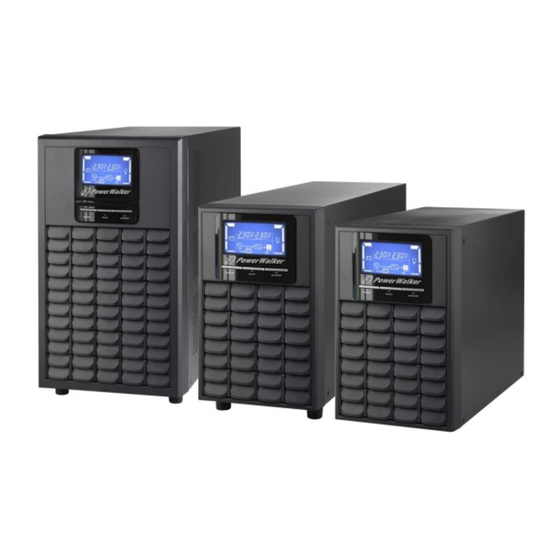
Aeris Swopper Montageanleitung
Vorschau ausblenden
Andere Handbücher für Swopper:
- Bedienungsanleitung (24 Seiten) ,
- Montageanleitung (2 Seiten) ,
- Bedienungsanleitung (20 Seiten)
Inhaltszusammenfassung für Aeris Swopper
-
Seite 19: Unterbrechungsfreie Stromversorgung (Usv)
Online-USV PowerWalker VFI 1000C LCD PowerWalker VFI 2000C LCD PowerWalker VFI 3000C LCD Bedienungsanleitung (DE) Unterbrechungsfreie Stromversorgung (USV) - Seite 21 Inhaltsverzeichnis 1. Wichtige Sicherheitshinweise ................... 1 1-1. Transport ......................1 1-2. Vorbereitung ....................... 1 1-3. Installation ......................1 1-4. Betrieb ........................ 1 1-5. Instandhaltung, Service und Fehlerbehebung ............2 2. Installation und Aufbau ....................3 2-1. Rückwand ......................3 2-2. Aufbau der USV ....................3 3.
-
Seite 22: Wichtige Sicherheitshinweise
1. Wichtige Sicherheitshinweise Bitte beachten Sie strikt alle Warnhinweise und Bedienungsanleitungen in diesem Handbuch. Verwahren Sie diese Anleitung gut auf und lesen sorgfältig die folgenden Anweisungen, bevor Gerät installieren. Nehmen Gerät nicht Lesen aller Sicherheitsinformation und Betriebsanleitungen in Betrieb. 1-1. Transport Bitte transportieren Sie die USV nur in der Originalverpackung, um es vor Stößen zu ... -
Seite 23: Instandhaltung, Service Und Fehlerbehebung
1-5. Instandhaltung, Service und Fehlerbehebung Die USV wird mit gefährlichen Spannungen betrieben. Reparaturen dürfen nur von qualifiziertem Wartungspersonal durchgeführt werden. Vorsicht - Stromschlagrisiko. Selbst wenn das Gerät ausgesteckt ist, sind Teile der USV immer noch mit dem Akku verbunden und stehen unter Strom. Vor jeder Art von Service und/oder Instandhaltungsmaßnahmen klemmen Sie die ... -
Seite 24: Installation Und Aufbau
2. Installation und Aufbau HINWEIS: Bitte überprüfen Sie das Gerät vor der Installation. Vergewissern Sie sich, dass kein Teil beschädigt ist. Bitte bewahren Sie die Originalverpackung für weiteren Gebrauch auf. 2-1. Rückwand 1000 2000 3000 8. Wechselstrom-Eingang 9. Eingangssicherung 10. USB-Port 11. -
Seite 25: Schritt 2: Usv-Ausgangsstecker
Schritt 2: USV-Ausgangsstecker Wenn Buchsen als Ausgänge vorhanden sind, schließen Sie die Geräte einfach daran an. Wenn Eingänge und Ausgänge in Form von Klemmen vorhanden sind, gehen Sie bei der Verdrahtung wie folgt vor: a) Entfernen Sie die Abdeckung über der Kabelklemmung. b) Empfohlen sind AWG14 oder 2,1mm Stromkabel für 3KVA (Modelle 200/208/220/230/240VAC). -
Seite 26: Betrieb
3. Betrieb 3-1. Tastenbedienung Symbol Funktion USV einschalten: Halten Sie die ON/Mute-Taste für mindesten 2 Sekunden gedrückt, um die USV einzuschalten. Alarm stumm schalten: Sobald die USV im Akkubetrieb ist, halten Sie diese Taste für mindesten 5 Sekunden gedrückt, um den Alarm ein- oder auszuschalten. - Seite 27 Display Funktion Laufzeit Zeigt die verbleibende Überbrückungszeit als Tortendiagramm. Zeigt die verbleibende Überbrückungszeit als Wert. H: Stunden, M: Minute, S: Sekunde Fehlermeldung Zeigt Warnungen und Fehler an. Zeigt Warnung- und Fehlerkodierung an. Die Codes sind im Kapitel 3-5 detailliert aufgelistet. Stummschaltung Zeigt an, dass der USV-Alarm deaktiviert ist.
-
Seite 28: Akustischer Alarm
3-3. Akustischer Alarm Akkumodus Ertönt alle 4 Sekunden Niedriger Ertönt jede Sekunde Akkustand Überlast Ertönt zweimal in jeder Sekunde Fehler Kontinuierlicher Alarmton Bypass-Modus Ertönt alle 10 Sekunden 3-4. LCD-Display Index der Formulierungen Abkürzung Anzeige Bedeutung Aktivieren Deaktivieren Escape Hohe Verlustrate Niedrige Verlustrate Akku Wandler... -
Seite 29: Frequenzumwandler Aktiviert/Deaktiviert Schnittstelle
220: Ausgangsspannung 220VAC 230: Ausgangsspannung 230VAC (Standard) 240: Ausgangsspannung 240VAC Für Modelle mit 100/110/150/120/127 VAC können Sie folgende Ausgangsspannung wählen: 100: Ausgangsspannung 100VAC 110: Ausgangsspannung 110VAC 115: Ausgangsspannung 115VAC 120: Ausgangsspannung 120VAC (Standard) 127: Ausgangsspannung 127VAC 02: Frequenzumwandler aktiviert/deaktiviert Schnittstelle Einstellung Parameter 2 &... - Seite 30 (Standard: +6V) LLS: Niedrige Verlustspannung im Stromsparmodus mit Parameter 2. Für Modelle 200/208/220/230/240 VAC, kann der Einstellungsbereich des Parameters 3 von -7V bis-24V der nominalen Spannung eingestellt werden. (Standard: -12V) Für Modelle 100/110/115/120/127 VAC kann der Einstellungsbereich des Parameters 3 von -3V bis -12V der nominalen Spannung eingestellt werden.
-
Seite 31: Beschreibung Der Betriebsmodi
3-6. Beschreibung der Betriebsmodi Betriebsmodus Beschreibung LCD-Anzeige Online-Modus Die USV erzeugt eine stabile, reine Wechselstromspannung, solange sich die Eingangsspannung im akzeptablen Bereich befindet. Der Akku der USV wird im Online-Modus geladen. Stromsparmodu Stromsparmodus: s (ECO-Modus) Wenn die Eingangsspannung im akzeptablen Bereich liegt, leitet die USV die Spannung direkt zum Ausgang, um Energie zu sparen. -
Seite 32: Fehlerreferenzcode
3-7. Fehlerreferenzcode Aufgetretener Fehlercode Symbol Aufgetretener Fehler Fehlercode Symbol Fehler Inverter Bus-Startfehler Niederspannung Inverter Bus über Ausgangskurzschluss Bus unter Akkuspannung zu hoch Akkuspannung zu Bus unausgeglichen niedrig Inverter Übertemperatur Softstart-Fehler Inverter Überlast Überspannung 3-8. Warnanzeige Warnung Symbol (blinkend) Alarm Niedriger Akkustand Ertönt jede Sekunde Überlast Ertönt zweimal in jeder Sekunde... -
Seite 33: Problembehebung
4. Problembehebung Wenn das USV-System nicht korrekt funktioniert, bitte das Problem anhand der nachstehenden Tabelle lösen. Symptom Mögliche Ursache Abhilfe Keine Anzeige oder Alarm trotz Das Stromkabel ist nicht Überprüfen, ob das normaler Stromversorgung. korrekt verbunden. Stromkabel fest eingesteckt ist. Das Stromkabel ist mit dem Stromkabel korrekt in den USV-Ausgang verbunden. - Seite 34 Symptom Mögliche Ursache Abhilfe Fehlercode 01, 02, 03, 04, 11, 12, Ein interner USV-Fehler ist Kontaktieren Sie Ihren 13 und 41 wird auf dem aufgetreten. Es gibt zwei Händler. LCD-Display angezeigt und der Möglichkeiten: Alarm ertönt kontinuierlich. 1. Die Stromversorgung erfolgt noch, jedoch direkt über den Bypass vom Wechselstromnetz.
-
Seite 35: Lagerung Und Instandhaltung
5. Lagerung und Instandhaltung Betrieb Das USV-System enthält keine Teile, die der Benutzer warten kann. Falls die Akkulebensdauer (3~5 Jahre bei 25°C Umgebungstemperatur) überschritten wurde, müssen die Akkus ausgetauscht werde. Kontaktieren Sie in diesem Fall Ihren Händler. Bringen Sie gebrauchte Akkus zum Recycling oder senden Sie sie zu Ihrem Händler. -
Seite 36: Spezifikationen
6. Spezifikationen MODELL 1000 2000 3000 KAPAZITÄT* 1000 VA / 800 W 2000 VA / 1600 W 3000 VA / 2400 W EINGANG 85 VAC/75 VAC/65 VAC/55 VAC ±5% oder 160 VAC/140 VAC/120 VAC/110 VAC ±5% Niedrige Überleitung (Umgebungstemp.<35 (abhängig von der prozentualen Last 100% - 80 % / 80 % - 70 % / 70 - 60 % / 60 % - 0) 95VAC/85VAC/75VAC/65VAC oder 175VAC/155VAC/135VAC/125VAC ±... -
Seite 38: Sistema De Alimentación Ininterrumpida
SAI Online PowerWalker VFI 1000C LCD PowerWalker VFI 2000C LCD PowerWalker VFI 3000C LCD Manual (EN, ES) Sistema de Alimentación Ininterrumpida...
















